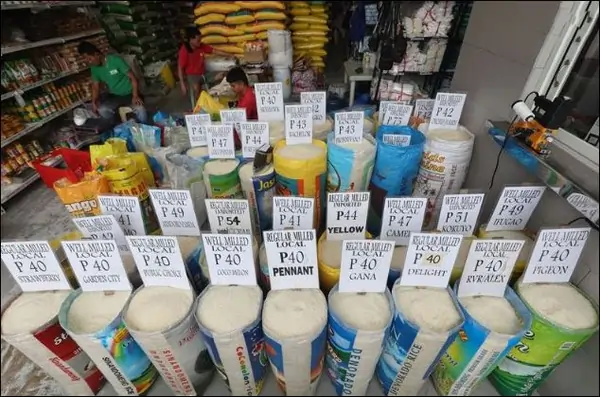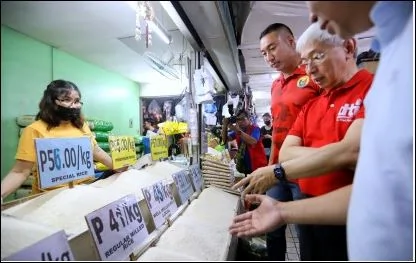Introduction to the DA Targets Strong Price Cap on Imported Rice in 2025
In response to concerns over rising rice prices, the Department of Agriculture (DA) has announced plans to implement a ‘Maximum Suggested Retail Price’ (MSRP) on imported rice starting in January 2025.

This initiative comes after reports of rice importers potentially profiteering, with some rice varieties still being sold for as much as P60 per kilo, despite tariffs being reduced since July 2024. Sec. Francisco Tiu Laurel Jr. confirmed this move on Monday, emphasizing the need to establish clear price guidelines for the benefit of Filipino consumers.
Table of Contents
The Issue of Rice Pricing and Profiteering
The rice industry in the Philippines has long been a subject of debate, especially Targets Strong Price Cap on Imported Rice. While tariffs were reduced last year to make rice more affordable, some retail outlets continue to sell imported rice at prices far higher than expected.

For instance, some varieties are still being sold for around P60 per kilo, which is considered too high given the tariff reductions. This has led to allegations that rice importers may be taking advantage of the situation to maximize profits, putting the burden on everyday consumers.
What the Department of Agriculture is Planning
The Department of Agriculture aims to tackle these concerns head-on by imposing an MSRP on imported rice. The primary objective of this move is to ensure that consumers are not overcharged for rice, a staple food item that forms the backbone of many Filipino households’ diets.
“We are now trying to establish ano ba dapat ang maximum suggested retail price,” said Sec. Francisco Tiu Laurel Jr. This statement underscores the government’s commitment to regulating rice prices to ensure fairness in the market.
Factors Affecting the MSRP for Imported Rice
The MSRP for imported rice will not be a one-size-fits-all figure. Instead, it will vary depending on the type and quality of the rice, with premium varieties priced higher than more standard types.
According to DA Spokesperson Assistant Secretary Arnel de Mesa, even high-quality imported rice should not exceed P50 per kilo. This price point reflects the costs associated with production, importation, and distribution before the rice reaches retail markets.
The Role of Rice Varieties in Determining the MSRP
Different varieties of rice, such as well-milled, regular milled, and broken rice, will be priced differently under the MSRP system. The government intends to set realistic prices based on the rice’s quality and the costs incurred in getting it to market.
“Beyond P60 is really too much kaya maglalagay ng MSRP so consumers will have an idea na ganito lang ang presyuhan niyan,” said Assistant Secretary de Mesa. This ensures transparency and helps consumers better understand the value they’re getting when purchasing rice.
Understanding the Impact of the MSRP on Consumers
The introduction of an MSRP is expected to benefit consumers by Targets Strong Price Cap on Imported Rice guidelines. With a set price limit, consumers will have a better understanding of how much they should be paying for rice, regardless of where they shop.
This measure aims to prevent price gouging and provide relief to families struggling with high food costs. It will also make it easier for consumers to compare prices across various retail outlets.
How MSRP Will Help Regulate the Rice Market
Imposing an MSRP is not just about setting a price cap; it’s about bringing stability to the rice market. By regulating rice prices, the DA aims to create a level playing field for rice traders and ensure that they pass on the benefits of lower tariffs to consumers.
The MSRP system will also discourage unscrupulous traders from taking advantage of the market and engaging in price manipulation, contributing to a more transparent and competitive marketplace.
DA’s Guidelines for Proper Labeling of Imported Rice
In addition to setting the MSRP, the DA has issued new guidelines for the Targets Strong Price Cap on Imported Rice. This includes mandatory information such as the country of origin, rice type, and the level of brokenness. These labels will help consumers make more informed decisions when purchasing rice and ensure that they are getting the quality they pay for.
This transparency is another crucial step toward empowering consumers and promoting fair trade practices in the rice industry.
Conclusion
The Department of Agriculture’s move to impose a ‘maximum suggested retail price’ (MSRP) on imported rice is a crucial step in ensuring that Filipino consumers are protected from excessive pricing in the rice market. With tariffs on imported rice reduced in 2024, the government is committed to ensuring that the benefits of these tariff cuts are passed on to the public.
By regulating the pricing of imported rice and requiring transparency in labeling, the DA aims to create a more competitive market, curb profiteering, and provide consumers with fairer prices.
This initiative is expected to foster trust in the rice market and offer much-needed relief to families, particularly those in lower-income brackets who are most affected by food inflation. As the MSRP system rolls out in January 2025, consumers can look forward to clearer pricing and greater market stability.
FAQs
Q1: When will the MSRP for imported rice take effect?
A1: The Maximum Suggested Retail Price (MSRP) for imported rice is scheduled to take effect in January 2025. This move by the Department of Agriculture aims to regulate rice prices and protect consumers from potential price gouging, ensuring fair pricing for various rice varieties.
The government is working on finalizing the price points based on the type and quality of rice before the policy is enforced.
Q2: How will the MSRP affect rice prices?
A2: The implementation of Targets Strong Price Cap on Imported Rice (MSRP) is expected to have a significant impact on rice prices by setting clear price caps, preventing overpricing, and ensuring that consumers are not burdened by inflated costs.
The MSRP will create a benchmark for rice prices, allowing consumers to know the maximum amount they should expect to pay based on the type and quality of rice. It will prevent importers from profiteering and ensure that the benefits of reduced tariffs are passed down to consumers.
By regulating prices, the MSRP aims to provide more affordable rice options, especially for lower-income families, while also promoting transparency in the rice market.
Q3: Will the MSRP apply to locally-produced rice?
A3: No, the Maximum Suggested Retail Price (MSRP) will only apply to imported rice. Locally-produced rice is regulated separately and will not be subject to the MSRP.
The Department of Agriculture’s policy focuses on regulating the prices of imported rice to ensure that consumers benefit from the reduced tariffs and avoid inflated prices. Local rice prices are determined by different factors and are governed by separate regulations.
Q4: How will consumers know the price of rice?
A4: Consumers will be able to know the price of rice through clear labeling and the DA Targets Strong Price Cap on Imported Rice in 2025 (MSRP) on rice packaging. Retailers will be required to show the MSRP, which will help guide consumers on what they should expect to pay for different varieties of imported rice.
Additionally, the packaging will include essential details such as the country of origin, rice type, and level of brokenness, providing further transparency and allowing consumers to make informed purchasing decisions. This system aims to promote fair pricing and prevent price manipulation in the market.
Disclaimer
The information provided in this article: DA Targets Strong Price Cap on Imported Rice in 2025 reflects the Department of Agriculture’s current plans regarding the implementation of a Maximum Suggested Retail Price (MSRP) for imported rice, set to take effect in January 2025.
These measures are subject to change as the DA finalizes the specifics and adjusts policies based on market conditions.
For the most accurate and up-to-date information, it is advised to consult official announcements from the Department of Agriculture. Prices and regulations could evolve as the government adapts to the dynamic challenges of the rice market. Always check with local retailers and official sources for the latest updates.
TechWirings does not endorse or explicitly support any views or actions expressed in this content.










